Nvidia GeForce RTX 4080 Super review: “the 4K GPU most players should opt for”
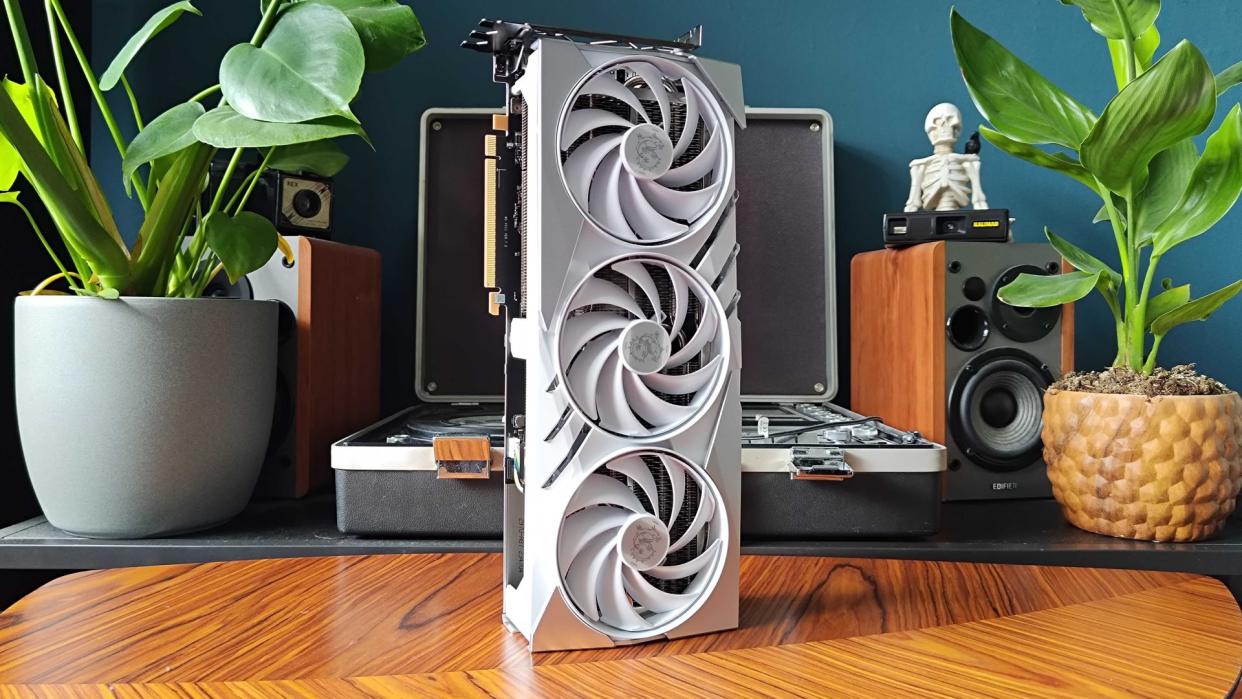
The Nvidia GeForce RTX 4080 Super serves as the cherry on top of the GPU giant’s Lovelace redemption arc. Rather than just handing you a garage station buquet, this revamped graphics card is outside your window with a guitar, serenading you about how it now costs under $1,000. Personally, that’s enough for me to open the door and invite it, but the fact it’s also wearing higher specs grants the green team’s 80-series further forgiveness.
That cheesy metaphorical intro sounds like I’ve got major beef with the original RTX 4080, but I’ve always considered it one of the best graphics cards around. My real gripe with the initial card was with its price, as it placed Nvidia's high end performance out of reach for many players. Plus, those enthusiasts that were looking to spend over a grand would likely find themselves eyeing up the superior Nvidia GeForce RTX 4090 instead, especially since the performance jump is massive.
Thankfully, that has all been remedied thanks to RTX 4080 Super prices starting at $999 / £989, providing a premium Nvidia GPU option that can rip through games at 4K without costing the same as some mid-range gaming PCs. If you don’t get hold of a Founder’s Edition card, you’ll end up paying a bit more for something like the MSI model I’m about to take a look at, but that lower base MSRP means you’re still ultimately paying less for a better GPU.
Specs
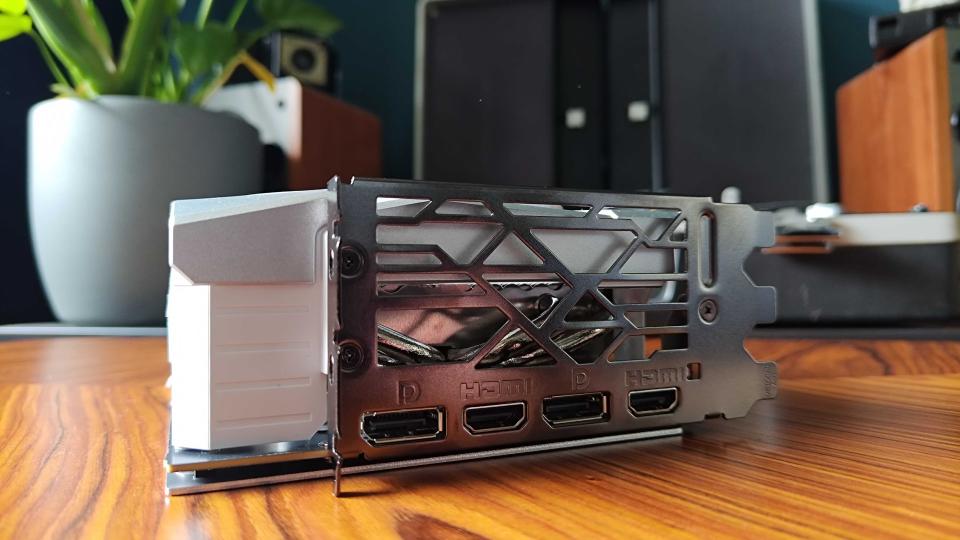
The specific model I’m using for our review is the MSI GeForce RTX 4080 Super GAMING X Slim. The card features almost the same specs at the Founder's Edition, but offers up a higher 2,610MHz and custom cooler for around $100 more. If you’re in the UK, you’ll be able to grab it at the likes of eBuyer for £1,099.98, while Newegg has the same model for $1,169.99 right now in the US.
Factory overclock aside, the RTX 4080 Super builds upon the original version’s specs with 10,240 CUDA cores, 320 tensor cores, and 76 dedicated to ray tracing. To save you doing the math, that’s a 5% increase compared to the OG model’s 9,728 shading units, which might not sound like a lot, but gives the AD103 GPU a bit more head room.
The card still boasts 16GB GDDR6X VRAM, allowing the new Nvidia GeForce RTX 4070 Ti Super to match it in the memory department. Not to spoil our performance segment, but I've yet to encounter any performance issues with this configuration when benchmarking, so I’d argue that 16GB is still enough for 4K gaming and demanding high res textures.
Design
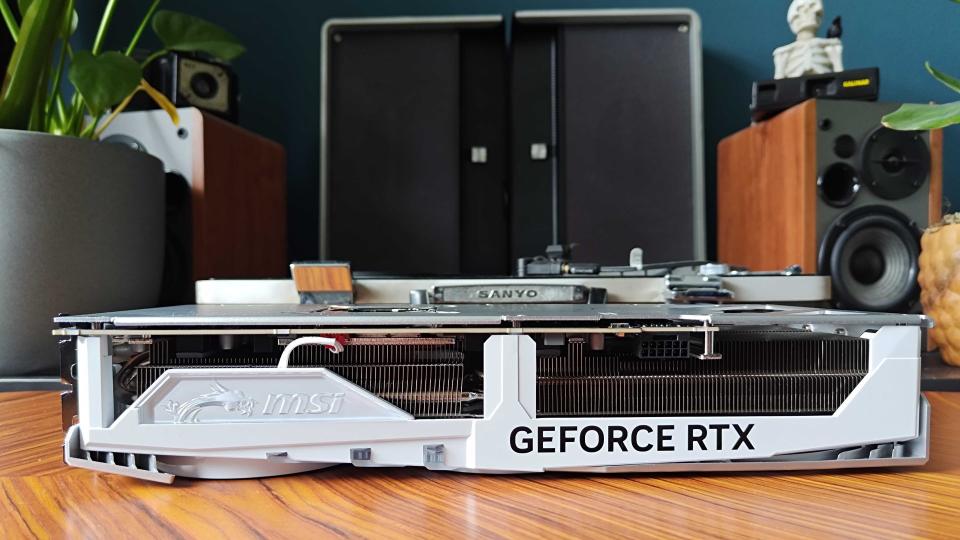
It’s no secret that Nvidia’s premium cards are chonky, and RTX 4080 Super cards maintain that large stature. I do prefer the look of Founders Edition cards to most custom models, as Nvidia's design manages to look make the bulk look a little sleeker. That said, the fact that the MSI GAMING X Slim I’m testing is white and silver distracts from its otherwise industrial-looking cooler, which would look a bit aggressive in black. Its RGB-lit jewel logo also provides a bit of pizazz to the boxy aesthetic, helping it not feel like a chunky PC case invader that takes up more space than any other component.
If you’re aiming for an all white PC build, you’ll be delighted to hear that the included adapter matches the card. However, if you’re anything like me, you’ll be bummed out by the fact that the dongle is still a thing, even though we’re unlikely to see a traditional connector ever again. I’m still holding out for manufacturers coming up with a way to move it away from the front of the card, as just like every other Lovelace card, placement makes cable management an absolute pain.
Beefy specs require efficient cooling, and the MSI GAMING X Slim’s triple TORX Fan setup fills the brief. With three fans accompanying the card’s chonky shroud, you won’t have to worry about shifting any heat, providing you give the card plenty of space to draw in air.
Features
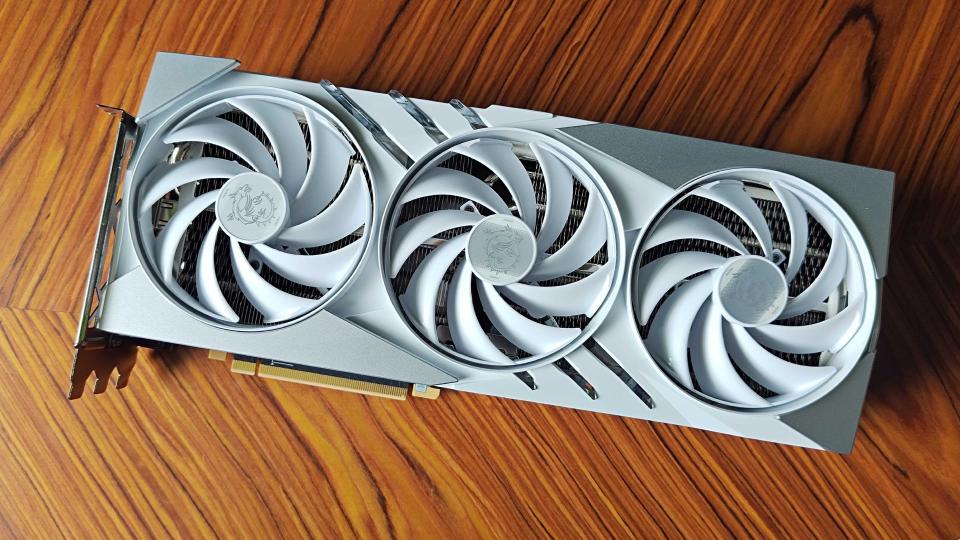
Investing in an Nvidia graphics card in 2024 pretty much means investing in its AI ambitions and, while that will turn some players off, the results are the reason why Lovelace cards are sitting pretty at the top. Tools like DLSS and Frame Generation have the ability to boost fps beyond what should be possible using native hardware, and newer features like Ray Reconstruction are out to impress with accurate lighting and visuals.
The catch? Well, not every game wields DLSS support, so it’s anything but a performance silver bullet. That said, the outings that do have the setting baked in can pull off incredible upscaling tricks that come with very few caveats. It feels like only a few years ago that you could notice the difference using an upscaler upon inspecting specific detailed textures, but I’m really struggling to spot any shenanigans these days when using Nvidia’s tools.
On the driver side of things, the RTX 4080 Super benefits from all the perks of GeForce Experience. Arming the card with capture capabilities, providing streaming functionality, and automatic game setting optimizations are all perks that come with using the app, even if its features have been a standard across the GPU scene for quite a while now.
Performance
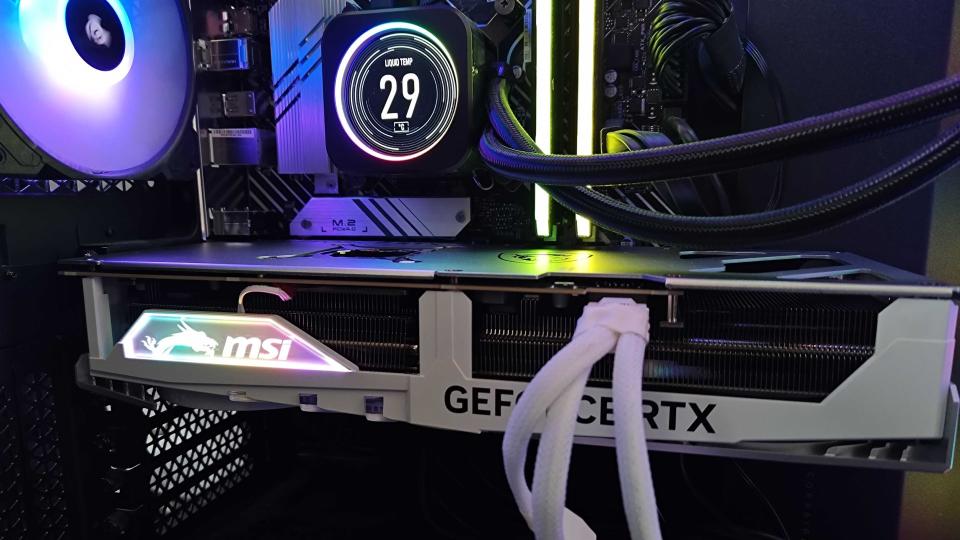
Before we dive into some benchmarks, it’s worth reiterating that the RTX 4080 Super isn’t a different class of card to the original. If anything, it proves to be more or less the same product with a cheaper price tag, providing a similar experience as the original during testing. Given the cheaper price tag, that’s not a bad thing, but don’t expect super levels of performance from this card.
I always like to kick off with Cyberpunk 2077, and I can finally include it again now that the weird 13th gen Intel issues have been patched. You won’t quite be able to consistently hit above 60fps at 4K without any AI assistance without tweaking some settings, but it won’t take much to hit that sweet spot. As always, switching on DLSS and Frame Generation completely changes the situation, as you’ll be able to boost fps to around 100 with ultra settings enabled without touching any dials. If you’re planning on giving Night City a lick of ray tracing paint, you’ll have to rely on Nvidia’s upscaler to hit over 30fps, with Frame Generation helping bring things up to a nifty 80fps.
RTX 4080 Super benchmark scores
OpenCL: 246,790
Vulcan: 175,674
TimeSpy: 24,701
Firestrike: 39,374
Hitman 3 usually plays nice with high end cards, and the RTX 4080 Super can ramp 4K frame rates up to 133fps. If you’re aiming to satiate a high refresh rate monitor, switching on DLSS elevates things to over 180fps, while switching ray tracing on will level things out with a 105fps average. No surprises there, but if you're looking to invest in this card over the cheaper RTX 4070 Ti Super, it will help you drive frame rates beyond 120fps.
In a change up to the norm, I decided to take Horizon: Forbidden West for a spin since it just released on Steam. It’s a fresh example of a big open world romp that comes with Nvidia DLSS and Frame Generation support baked in, and it's a game that could convince fans of the series to upgrade to an RTX 4080. I mean, if you’re using your PC as a homemade PS5, you’re going to want your $1,000 graphics card to seriously impress, right?
Well, don’t worry folks, as Horizon: Forbidden West is pretty incredible on the RTX 4080 Super. I was able to send Aloy down the beaten path at a respectable 78fps at 4K with highest settings enabled, and everything felt notably smoother than the console version. My eyeballs were so content with the experience that I almost forgot to switch on Frame Generation, and eventually doing so was a little surreal.
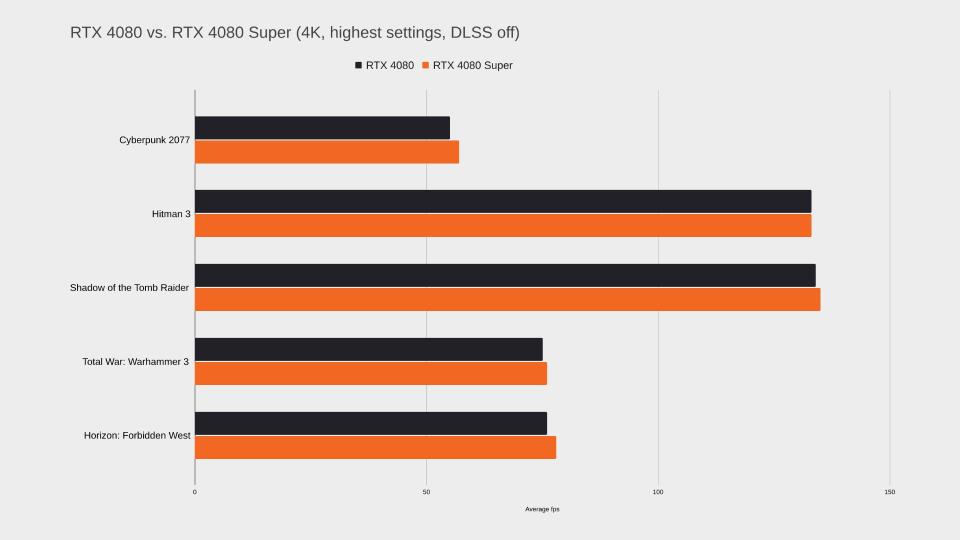
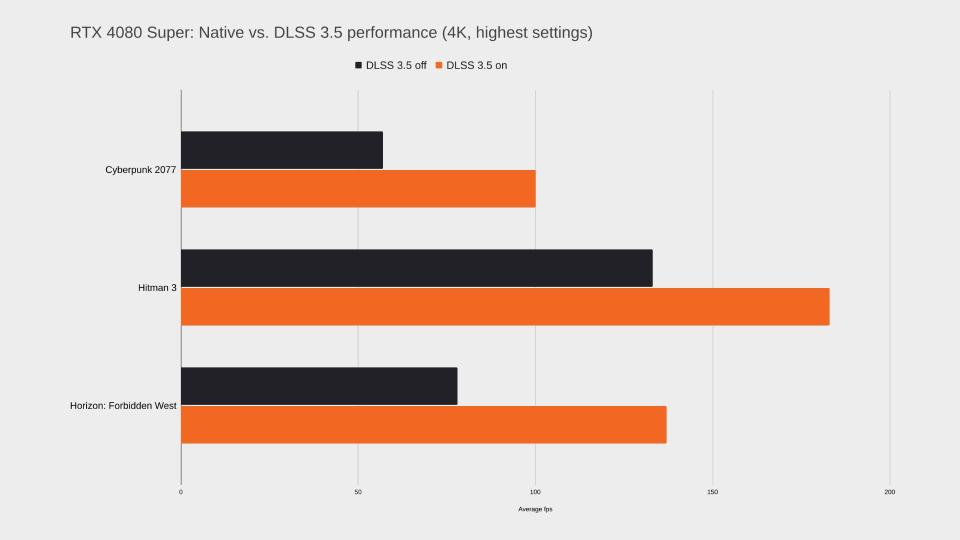
With AI upscaling and Frame Generation switched on, frame rates skyrocketed to around 137fps, transforming the sequel’s visuals into something made for premium gaming monitors. I was skeptical of inevitable caveats at first, so I immediately started zooming into the game’s array of complex textures and foliage in search of artefacts and weirdness. Yet, apart from some minor monetary aliasing oddities around characters during cutscenes, I couldn’t find any other upscaling warts, and I reckon I’d struggle to tell the difference if I wasn’t specifically looking.
Moving onto outings that aren’t armed with frame generation, and I’m pretty pleased with Total War: Warhammer 3 on the RTX 4080 Super. I was able to comfortably hit 76fps with everything cranked up to max, which isn’t half bad considering how demanding the RTS game’s chaotic battlefield can be.
As for temperatures, I rarely noticed things drift past 70°c, with readings generally hovering at around 62°c under full load. It’d take a big workload to get this card anywhere near its 90°c limit, and keeping things frosty doesn’t come with noise caveats attached. While I don’t go out of my way to actually measure loud GPUs, with game volume muted, I couldn’t specifically hear the RTX 4080 Super over other coolers like my case fans.
Should you buy the Nvidia GeForce RTX 4080 Super?
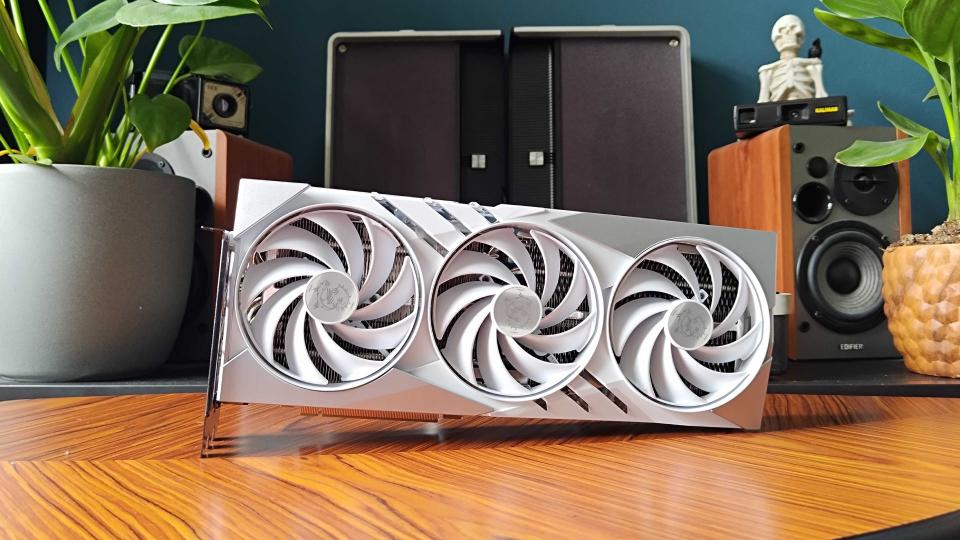
Out of Nvidia’s Lovelace line up, the Nvidia GeForce RTX 4080 Super is the 4K graphics card most players should opt for. It’s still firmly a member of the premium party, and cards like the MSI GAMING X Slim will come with a custom tax attached. Nevertheless, If you’re serious about building a high spec rig, or you’re looking to make the jump from the RTX 20-series or older, the RTX 4090’s cheaper sibling is going to open the door to a slightly more approachable UHD experience.
How I tested the Nvidia GeForce RTX 4080 Super
I used the RTX 4080 Super within my main rig for playing games and carrying out everyday tasks for a week. During that time, I benchmarked the card using a suite of specific games, including Cyberpunk 2077, Hitman 3, Shadow of the Tomb Raider, and Total War: Warhammer 3, but also kickstarted a Horizon: Forbidden West playthrough and recorded average frame rates throughout the start of the apocalyptic adventure.
If you’d like to learn more about how we test graphics cards and other PC components, swing by our GamesRadar+ Hardware Policy to learn more.
Looking for more components? Check out the best SSD for gaming and best gaming RAM options. Alternatively, take a peek at the best gaming handheld for portable rigs you can take on the go.

